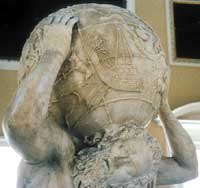| |
So
far as we know, the first people to map the positions of stars were the
Chinese astronomers Shi Shen, Gan De and Wu Xian in the third and fourth
century BC. Their work was passed along over the centuries in various
media, although inaccurately. The earliest copy we have is a star map
from the Tang Dynasty (roughly 9th century AD), discovered in modern times
in the ruins of a monastery in the deserts of central Asia.

The
constellations as seen by ancient astronomers
in China, in a copy of a copy of a 4th-century BC star map.
The earliest
Western catalog of stars was created by the Greek astronomer Hipparchus
around 129 BC, building on earlier work going back to the Babylonians.
Most of Hipparchus’s work was lost, although later astronomers used
parts of it. A record of his star map may be preserved in the celestial
globe on a second-century AD statue of Atlas, recovered from Roman ruins
during the Renaissance.

Roman
statue of Atlas bearing the heavens showing constellations, possibly
from a 2nd-century BC Greek star map, including mythical images still
more ancient. |
The early
Chinese, Babylonians and Greeks were chiefly interested in how the Sun,
Moon and planets moved through the patterns the stars made on the sky.
A main aim was astrological predictions. But each culture grouped stars
in different “constellations,” and astrologers were never
able to agree on a system for prediction. Astrology was a grand first
attempt at cosmology
—
that
is, a system for understanding the workings of the universe
—
but
it could never develop into a science. For the world is not in fact influenced
by the positions of stars. After all, the patterns they form would look
completely different if they were viewed from some other position in space.
|


